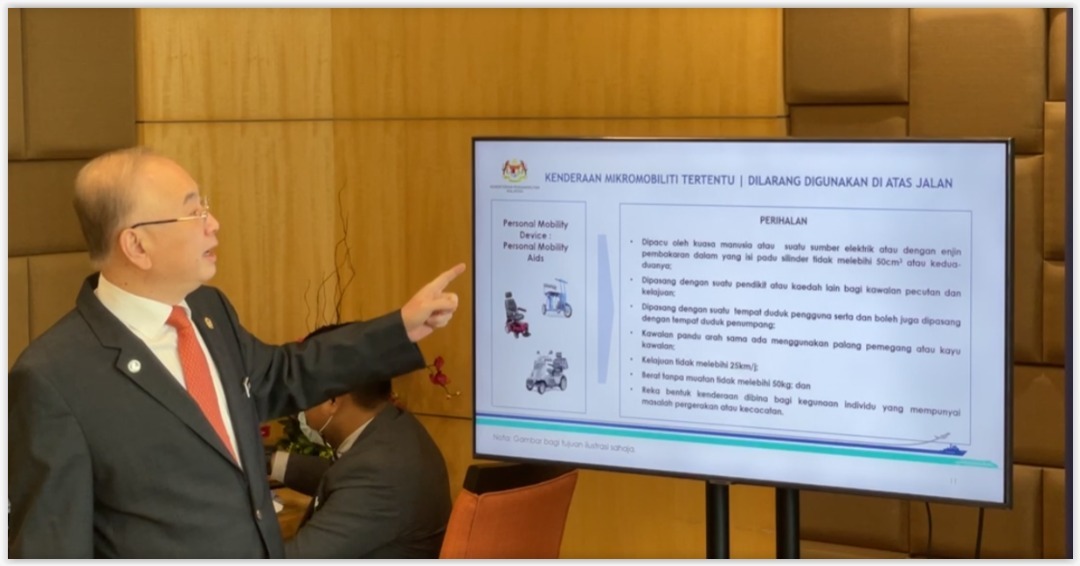KUALA LUMPUR, April 27 – Transport Minister Wee Ka Siong clarified today that people with disabilities (OKU) can use wheelchairs on pedestrian walkways.
Wee’s clarification came after he told a press conference yesterday that OKU are now prohibited from using manual and electric or motorised wheelchairs, or other personal mobility aids, on the road.
“If they use wheelchairs on pedestrian walkways, that’s not a problem,” Wee told CodeBlue when contacted today.
Roads in the capital city typically lack pedestrian walkways, forcing both pedestrians and OKUs to walk or use their wheelchairs on the side of the road to get around. Pedestrian walkways are also often blocked with obstacles.
When CodeBlue pointed this out, Wee said: “No issue.”
In a press statement Wee issued later today, he said that OKU and people with health issues can use personal mobility aids by sitting on these devices “on pedestrian lanes on the road to cross the road”. He also said personal mobility aids could be used in shopping centres, pedestrian lanes or shop sidewalks, and parks that are exempt from the Road Transport Act.
“In formulating this policy, MOT (Ministry of Transport) had held a discussion session with the Welfare Department, OKU Central and PWD associations on 23 April 2021 to get input from these parties on the enforcement of the prohibition of the use of micromobility.”
At his press conference yesterday, Wee referred to a slide of personal mobility devices propelled by human power depicting a skateboard, a manual wheelchair, and a scooter, saying that “all these three” cannot be used on the road as it is “dangerous”.
On another slide of personal mobility aids either propelled by human power, electricity, or with an internal-combustion engine of which the cylinder capacity does not exceed 50cm3, including electric or motorised wheelchairs, Wee specifically said that these devices are used by OKU, but are prohibited on the road.
“These devices are designed for the use of individuals with mobility issues or disabilities. These are also not allowed. It’s not that we ban them from using it. They can use OKU cars, we give them road tax-free.
“However, these devices can be dangerous if they’re permitted on the road. They can use them anywhere, but not on the road used by other road users.”
Use of other personal mobility aids used by OKU on the road is also illegal. A picture depicting a female OKU and her child on a personal mobility aid, Wee said: “It’s for OKU, but the child is not OKU. This is what we prohibit. If we don’t stop this, there will be tragedy.”
Personal mobility devices powered by electricity or with an internal-combustion engine of which the cylinder capacity does not exceed 50cm3 are similarly prohibited on the road, such as electric scooters.
Wee claimed at his press conference that electric scooters are used for racing like basikal lajak (modified biycles).
Despite Wee’s remarks to CodeBlue today that wheelchairs can be used on pedestrian walkways, the minister said clearly in his press conference yesterday that as per the Road Traffic (Prohibition of Use of Certain Micromobility Vehicles) Rules 2021, which came into effect last December 17, the use of mopeds, personal mobility devices, and personal mobility aids is prohibited on “any part of any road, including crossings (jejantas)”.
“People cannot use them on crossings to cross the road,” Wee said yesterday.
The only micromobility devices permitted on the road, Wee said in his press conference, are bicycles (including electric bicycles) and trishaws. Basikal lajak remain illegal on roads.
“Only electric bicycles that follow the specifications of Malaysia Standard MS2514: Electric Bicycles (Electric Pedal Assisted Bicycles) Specification are allowed on the road, by complying with the same rules as set for the use of bicycles,” said Wee.
The Road Traffic (Prohibition of Use of Certain Micromobility Vehicles) Rules 2021, as gazetted by Wee last December, specifically prohibit the use of certain micromobility vehicles – mopeds, personal mobility devices, and personal mobility aids – “on any part of any road”. Clause 3(2) empowers the minister to exempt application of the regulation “on any road or any part of the road subject to any conditions as the Minister may determine.”
This regulation indicates that OKUs cannot legally use wheelchairs even on the side of the road in the absence of pedestrian walkways.
Wee said in his press conference yesterday that mopeds, or any personal mobility device or aid, could only be used on pathways specifically designated by local authorities.
However, Kuala Lumpur generally lacks bicycle pathways, as city planning prioritises cars and motorcycles over pedestrians and cyclists.
The transport minister said those who use the prohibited micromobility vehicles on the road will be committing an offence under the Road Transport Act 1987.
Wee’s remarks came amid renewed controversy surrounding the case of Sam Ke Ting, who has appealed a High Court decision that sentenced the female clerk to six years’ jail for reckless driving that caused the death of eight teenagers on basikal lajak in Johor in 2017.
Update: This article was updated with Wee’s media statement in paragraphs 6 and 7.








